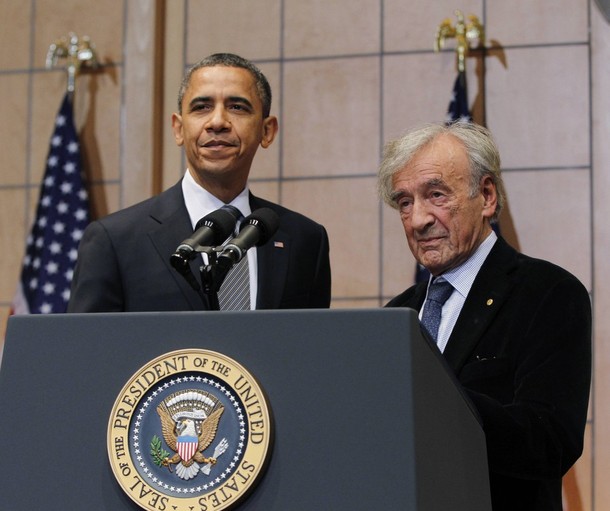President Obama and the Atrocities Prevention Board
On April 23, Obama marked Yom HaShoah (Holocaust Remembrance Day) by touring the U.S. National Holocaust Memorial Museum, accompanied by Survivor and Nobel Laureate Elie Wiesel. He then delivered a seminal speech, announcing the creation of an Atrocities Prevention Board (APB) and declaring that the prevention of genocide is “a core national security interest and a core moral responsibility of the United States.” In this article, I will briefly explain the initiative and offer some thoughts for Canadians who share the President’s resolve but may be disenchanted with current state of affairs.
Obama’s APB may have a dull name, but it promises to be a powerful mechanism lending support to genocide prevention initiatives. According to the Enough Project, the APB will “institutionalize a comprehensive strategy that will transcend political boundaries as part of a permanent government structure to further cement the norms of international human rights throughout the U.S. and the world.”
![paisleyboat-300[1]](http://mindthis.ca/wordpress/wp-content/uploads/2012/05/paisleyboat-3001.jpg)
Civil Society Inclusion
In an election year, “transcend[ing] political boundaries” and accompanying rhetoric-spewing can only be a good thing. While many applauded Mitt Romney for his response to the recent Act for Sudan call-to-action — Romney’s statement spoke of a commitment “to protecting innocents” in Sudan and South Sudan — the pervasive assault on human rights throughout the world demands more than mere politicking. Obama, declaring that “awareness without action changes nothing,” has responded by empowering one of his top advisers, Samantha Power, to build the APB into a collabora
Another strength of the APB is its preventative nature – it’s in the name, too. Until now, the international community has failed to prevent genocide and mass atrocity and has proven itself unable to adequately respond diplomatically, militarily or otherwise once a campaign of murderous impunity has been launched.tive centre of excellence. Recognizing that “change comes from the bottom up, from the grassroots,” to use the President’s words, the APB will engage activists from civil society.
So what will the APB actually do? The current plan is to :
- Help the U.S. government identify and address atrocity threats, and oversee institutional changes that will make us more nimble and effective.
- Collect and analyze information so as to better anticipate, understand, and counter atrocity threats
- Diplomats will encourage more robust multilateral efforts to prevent and respond to atrocities.
- Increase the capacity and develop doctrine for US foreign service, armed services, development professionals, and other actors to engage in the full spectrum of smart prevention activities
- Deploy new tools such as sanctions against those who commit or facilitate grave human rights abuses via information technology (“GHRAVITY sanctions”) related to Syrian and Iranian regime brutality.
- Work with US allies in order to ensure that the burdens of atrocity prevention and response are appropriately shared – cue Canada! (see below).
- Ensure that key decision-makers receive early warning and hear dissenting views.
As an architect of the Responsibility to Protect (R2P) doctrine – whose 10th anniversary is being marked this year – Canada has failed thus far to take comprehensive, preventative action of the kind sanctioned by Obama last month. Perhaps what makes this sting so bad is that Obama’s initiative is in many respects inspired by Canadian scholarship — not only R2P, but also — and more recently — the Will to Intervene project of the Montreal Institute for Genocide and Human Rights Studies at Concordia University.
At a similar Yom HaShoah ceremony – this one in Ottawa – Prime Minister Stephen Harper also reaffirmed his vow: “never again.” However, Lt. Gen. Sen. Roméo Dallaire et al., in an Ottawa Citizen piece, noticed a key difference between the two world leaders: “Unlike the prime minister, the president made a solid commitment, creating a forward looking policy structure that will put the Obama administration on the right side of history.”
Dallaire praised the government’s important role in preventing a promised bloodbath in Ghadaffi’s Libya, but noted that the “Libya mission will remain an improvised, “one off” event unless [the Canadian] government delivers an integrated and coherent strategy aimed at preventing mass atrocities and recognizes mass atrocity prevention as a key national interest and security priority of the government of Canada.”
No Bite?
Plans for a National Holocaust Monument as well as the soon-to-open Human Rights Museum are both, well, monumental endeavours with regard to educating Canadians and generating public consciousness. Yet, compared to the APB, we do seem to be lagging behind. Whereas the APB was ordered by the Oval Office, Canada is currently working off of a seriously under-funded All-Party Group for the Prevention of Genocide, which has no real tools for influencing policy aside from the good and powerful name of Senator Dallaire. Well-articulated recommendations by the student-driven STAND and other organizations for a permanent House of Commons subcommittee on genocide prevention have unfortunately not been acted upon.
The good news is that Canada has the opportunity to join the United States in strengthened, multilateral action to protect civilians, promote human rights, and make “Never Again” a reality.



